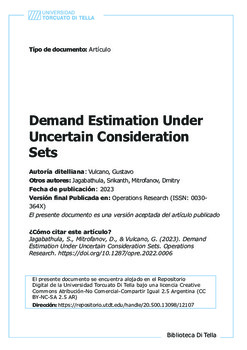| dc.rights.license | https://creativecommons.org/licenses/by-sa/2.5/ar/ | es_AR |
| dc.contributor.author | Vulcano, Gustavo | es_AR |
| dc.contributor.author | Jagabathula, Srikanth | es_AR |
| dc.contributor.author | Mitrofanov, Dmitry | es_AR |
| dc.date.accessioned | 2023-10-17T17:21:23Z | |
| dc.date.available | 2023-10-17T17:21:23Z | |
| dc.date.issued | 2023-09 | |
| dc.identifier.uri | https://repositorio.utdt.edu/handle/20.500.13098/12107 | |
| dc.identifier.uri | https://doi.org/10.1287/opre.2022.0006 | |
| dc.description.abstract | To estimate customer demand, choice models rely both on what the individuals do and do not purchase. A customer may not purchase a product because it was not offered but also because it was not considered. To account for this behavior, existing literature has proposed the so-called consider-then-choose (CTC) models, which posit that customers sample a consideration set and then choose the most preferred product from the intersection of the offer set and the consideration set. CTC models have been studied quite extensively in the marketing literature. More recently, they have gained popularity within the operations management (OM) literature to make assortment and pricing decisions. Despite their richness, CTC models are difficult to estimate in practice because firms typically do not observe customers' consideration sets. Therefore, the common assumption in OM has been that customers consider everything on offer, so the consideration set is the same as the offer set. This raises the following question: When firms only collect transaction data, do CTC models provide any predictive advantage over classic choice models? More precisely, under what conditions do CTC models outperform (if ever) classic choice models in terms of prediction accuracy? In this work, we study a general class of CTC models. We propose techniques to estimate these models efficiently from sales transaction data. We then compare their performance against the classic approach. We find that CTC models outperform standard choice models when there is noise in the offer set information and the noise is asymmetric across the training and test offer sets but otherwise lead to no particular predictive advantage over the classic approach. We also demonstrate the benefits of using CTC models in real-world retail settings. In particular, we show that CTC models calibrated on retail transaction data are better at long-term and warehouse level sales forecasts. We also evaluate their performance in the context of an online platform setting: a peer-to-peer car sharing company. In this context, offer sets are even difficult to define. We observe a remarkable performance of CTC models over standard choice models therein. | es_AR |
| dc.description.sponsorship | Este documento es la versión aceptada del artículo publicado en Operations Research (ISSN 0030-364X) en Septiembre de 2023 | |
| dc.format.extent | 90 p. | es_AR |
| dc.format.medium | application/pdf | es_AR |
| dc.language | eng | es_AR |
| dc.publisher | Operations Research (ISSN: 0030-364X) | es_AR |
| dc.rights | info:eu-repo/semantics/openAccess | es_AR |
| dc.subject | choice-based demand | es_AR |
| dc.subject | Consideration sets | es_AR |
| dc.subject | Consider-then-choose models | es_AR |
| dc.subject | Peer-to-peer platforms | es_AR |
| dc.subject | Retail operations | es_AR |
| dc.subject | Market anaytics | es_AR |
| dc.subject | Data analysis | es_AR |
| dc.title | Demand Estimation under Uncertain Consideration Sets | es_AR |
| dc.type | info:eu-repo/semantics/article | es_AR |
| dc.type.version | info:eu-repo/semantics/acceptedVersion | es_AR |

